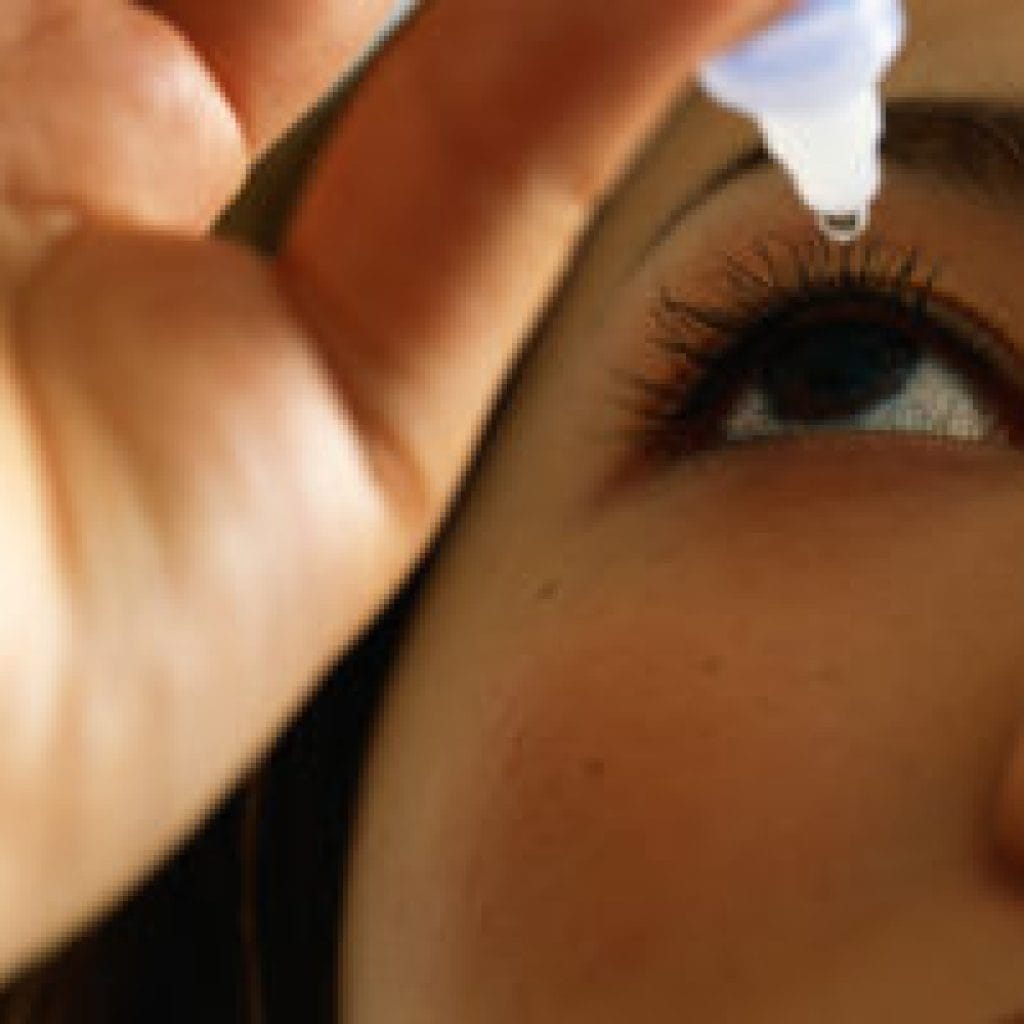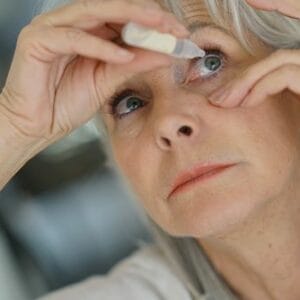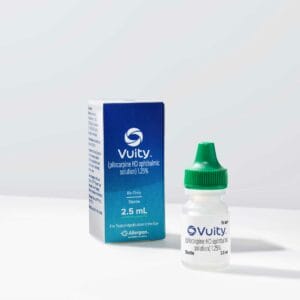April 11, 2023
One of the holy grails in eye care has been finding a cure for presbyopia that doesn’t involve spectacle lenses or contact lenses. Near the end of 2021, Allergan came the closest to achieving that goal with the approval of Vuity, a presbyopia-correcting eye drop. The commercial release of Vuity in January 2022 brought a great deal of fanfare, no doubt the result of a strong marketing campaign that included magazines, social media, and even direct-to-consumer commercials. It was even discussed on the talk shows with great enthusiasm. Presbyopia has long been a significant issue for countless millions of people worldwide over the age of 40, and this was going to be a big deal!
Patients on Vuity Achieved ‘Functional Near Acuity’
Vuity generated a lot excitement and anticipation, except in the eye care community where the only thing it generated, it seemed, was a great deal of negativity. After all, this was nothing more than 1.25% pilocarpine, a glaucoma drug with a host of side effects that had been around for more than 100 years and widely used until the 1990s when a number of better and more efficient drugs became available and pilocarpine became a footnote in the history books.
It didn’t seem to make a difference in the eye care community that Vuity actually worked. That’s not to imply that patients were able to read 20/20, but that wasn’t the goal. The fact is, a greater proportion of patients on Vuity were able to have “functional near acuity,” meaning they were able to perform their daily tasks without needing to put on their glasses.
In the GEMINI 1 and 2 phase three clinical trials (N = 750 participants aged 40 to 55 years), a significantly greater proportion of patients treated with Vuity gained at least three lines in mesopic, high-contrast, binocular distance corrected near visual acuity (DCNVA) compared to a placebo. Specifically, 75% of patients achieved at least a two-line improvement in mesopic DCNVA, and 93% achieved a photopic DCNVA of 20/40 or better.1-2 That is to say, most patients were able to see their smartphones, computer monitors, and read the newspaper, among many other near tasks, without needing glasses. How could that not be exciting! Well, it is just pilocarpine and there are some important considerations.
The Pros and Cons of Pilocarpine
It is well known that pilocarpine is a parasympathomimetic drug that causes pupillary miosis by contraction of the iris ciliary muscle on the iris sphincter. An interesting byproduct of pupillary miosis is increased depth of focus that is created from the pinhole affect. When placed at the iris plane, it extends the depth of focus, allowing for the ability to see up close without restricting peripheral vision. Unfortunately, with that comes a host of side effects, most of which are minimal and temporary. Patients did experience some diminution of their vision from the miosis as well as a mild headache or brow ache, but these seemed to go away the longer the drug was used. Pilocarpine is acidic by nature, having a pH of 4.5, so it can sting when it goes in the eyes, however, Allergan did an excellent job formulating the drop so it rapidly adapts to the pH of the tear film to minimize the stinging.
The treatment effect of pilocarpine is short lived, so being able to see at near only lasts around four to six hours, so the FDA has approved a twice-daily dosing option of Vuity. Interestingly, cost did not seem to be a factor as there is no insurance coverage, and the price at most retail pharmacies was around $80, which patients didn’t seem to mind paying.
Among the Side Effects are Retinal Complications
What has emerged as a significant side effect from pilocarpine are the retinal complications, mainly retinal tears and retinal detachments. This was born out from our experience in treating glaucoma where pilocarpine was used with caution in high myopes and patients with peripheral retinal disease because of the well-known retinal complications. Though this was talked about when we were treating glaucoma, it was rarely seen. Indeed, in GEMINI 1 and 2 with 750 patients treated, there were no cases of retinal tears or detachments reported.1 Keep in mind, these were patients 40 to 55 years of age, with near emmetropic refractive error and most not likely having developed posterior vitreous detachment (PVD).
Within a few months of the commercial release of Vuity, cases of retinal complications began to emerge. The first reported cases appeared in the American Journal of Ophthalmology in May 2022 where the authors described three cases of retinal detachment in two patients who were using pilocarpine for presbyopia.3 More cases followed. As of December 2022, there have been 30 cases of retinal detachments and 19 cases of retinal tears reported to the FDA Adverse Events Reporting System (FEARS) public dashboard. In addition, myriad other visual complaints have also been reported, including 39 cases of PVD and 50 cases of floaters. Vitreomacular traction has been reported but none on the FEARS public dashboard.4
Patient Selection is an Important Factor
The incidence of retinal complications seems significant, but it’s important to consider there have been over 150,000 commercial prescriptions for Vuity as of December 2022, which equates to an approximate risk of 0.02% of retinal detachment.5 What’s more, since this information has come to light, providers have been more careful with patient selection. Many practitioners have now implemented screening protocols emphasizing the importance of a dilated fundus exam in addition to widefield imaging and OCT of the macula in order to identity higher risk patients. Patients with peripheral retinal pathology, for example, may be told they are not candidates for Vuity. Indeed, the number of retinal complications reported in the FEARS dashboard had greatly declined in the second half of 2022 compared to the first half, so the incidence may be much lower taking this into consideration.
So why are we seeing what seems to be more retinal complications with Vuity than when we were using pilocarpine to treat glaucoma? There may be a number of reasons. Keep in mind that pilocarpine also induces forward displacement of the lens and vitreous due to ciliary and iris muscle contraction. This forward displacement of the vitreous can induce traction on the retina and in more vulnerable eyes such as high myopes, lattice degeneration, eyes without a PVD, or any combination, so it’s easy to understand why the risk would be higher. But, the high myope is not the typical patient for Vuity unless they happen to be pseudophakic or are wearing contact lenses and using Vuity as an emmetrope would. It’s not known how many retinal tears or retinal detachments fall into that category; likely not many.
The presence or absence of a PVD is important! Consider that Vuity is being used in a younger population (compared to glaucoma) and many will not have developed a PVD. Every time a drop gets instilled there is anterior displacement of the vitreous that potentially induces traction on the retina, not just the peripheral retina but the posterior pole and macula as well. After four to six hours the effect of the drop wears off and the vitreous returns to its normal physiologic state.
In an elderly glaucoma population, most patients likely already had a PVD and were using drops four times a day, every day. There really wasn’t an opportunity for the treatment effect of the drop to wear off, and if it did, there was likely minimal traction on the retina because of the PVD. Whereas in the presbyopia-treating population, the drop is only being used once or twice a day, so the forward movement of the vitreous occurs more frequently, perhaps every day or multiple times a day. So, in vulnerable patients at various stages of presbyopia, the effect of the vitreous on the retina from pilocarpine may be accelerating physiologic changes, such as PVD, or even inducing other more serious complications such as VMT, retinal tears, and retinal detachment.
This underscores why patient selection becomes important as well as making sure patients are aware of the potential complications of the pilocarpine drugs to treat presbyopia. Identifying at-risk patients is critical to reduce the risks. This can be done via a dilated fundus exam, widefield imaging, and OCT. There are various economic strategies for incorporating screening protocols into a practice.
The fact is that the overall risks of a retinal complication is exceedingly low and shouldn’t be a reason for not prescribing Vuity. After all, the medication works! Many patients are able to see at near without needing glasses, and patients should be made aware there is an option to treat presbyopia that doesn’t involve spectacles. That’s important because other presbyopia-treating eye drops will be coming to the market, possibly as soon this year.
What Presbyopia Eye Drops Are in the Pipeline?
Orasis Pharmaceuticals has the next presbyopia-treating eye drop, CSF-1, that will likely be approved in early 2024. The data from the phase three pivotal trials, NEAR1 and NEAR2, are currently under review by the FDA and show similar efficacy to Vuity. It incorporates the same pinhole-effect strategy using pilocarpine, except CSF-1 contains a lower concentration of pilocarpine, 0.4%, formulated in a proprietary multifaceted vehicle with a pH of 6, making it very comfortable on instillation.6 Their submission is based on a twice daily dosing. Like Vuity, there were no reported retinal complications in the phase three clinical trials of over 600 patients. It would be interesting to know if the lower concentration of pilocarpine will reduce the risk of retinal complications. We will probably not know the answer because the incidence will likely already be much lower after learning from the experiences with Vuity.
There are a few other presbyopia-treating eye drops being studied, but they are not as far along as CSF-1. All utilize pupillary miosis to increased depth of focus. Eyenovia uses pilocarpine 2% in a unique spray-mist delivery device. They are in phase three clinical trials. Visus Therapeutics is conducting phase three trials with an eye drop that utilizes carbachol 2.75% combined with brimonidine. Ocuphire Pharma, Inc. is just beginning phase three studies. Its drug utilizes pilocarpine 0.4% and phentolamine, which is an alpha-adrenergic agonist. It will be a few years for any of these new medications, if successful, to come to market.
In the meantime, the search for the holy grail of presbyopia continues. Will Vuity, or any of these presbyopia-treating eye drops, be the great panacea of providing a spectacle-free/contact-lens-free solution for our patients? Will the eye care community embrace these as legitimate solutions for our patients?
Ultimately, it will be up to our patients to decide if these are effective treatments. Are patients with presbyopia really so frustrated they will want to use an eye drop with myriad side effects that needs to be instilled up to twice a day for optimal efficacy, or will the burden of the treatment be worse than the disease? If the performance of Vuity over the past year is any indication, patients may continue to look for something better.
References
1 Waring GO, Price FW, Wirta D, et al. Safety and efficacy of AGN-190584 in individuals with presbyopia: the GEMINI 1 phase 3 randomized clinical trial. JAMA Ophthalmol. 2022;140(4):363-371.
2 Abbvie. U.S. Food and Drug Administration approves VUITYTM (pilocarpine HCI ophthalmic solution) 1.25%, the first and only eye drop to treat presbyopia (age-related blurry near vision). Oct 2021.
3 Al-khersan H, Flynn HW Jr., Townsend JH. Retinal detachments associated with topical pilocarpine use for presbyopia. Am J Ophthalmol. May 20, 2022.
4 FDA Adverse Events Reporting System (FAERS) public dashboard. Vuity (P). Accessed February 7, 2023.
5 Dunbar, MT. Cunningham DN, Garlich J, eta l. Reshaping Eye Care: Innovative Pharmaceutical Options for Presbyopia. Evolve medical Education. Supplement to Modern Optometry. Jan/Feb 2023.
6 Orasis Pharmaceuticals concludes phase 3 clinical trials for presbyopia candidate. Press Release. Mar 2022.





